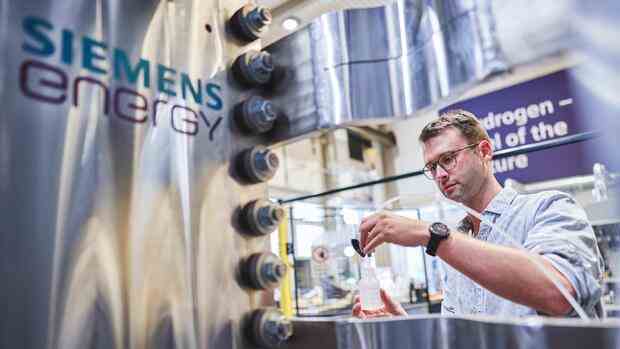Munich Siemens Energy wants to benefit greatly from the expected hydrogen boom in the USA. “The market is attractive and it may well be that we will build a factory in the USA at some point,” said Anne-Laure Parrical de Chammard, board member of the Handelsblatt.
The hydrogen economy will receive an enormous boost from US President Joe Biden’s “Inflation Reduction Act” (IRA). However, the planned growth in the USA does not mean a shift away from Germany, emphasized the Siemens Energy board member.
It is particularly interesting for the hydrogen industry that the USA wants to promote hydrogen at three dollars per kilo as part of the IRA. According to industry insiders, this means that many projects that previously would not have been economical will pay off in the future.
Parrical de Chammard emphasized that Siemens Energy had not yet made a decision to have its own production facility in the USA. A group spokesman added: “We are already well positioned for the US market with our concept: The heart of the electrolysers, the stacks, are manufactured in Berlin and could then be assembled in the USA together with regional partners.”
Gigafactory in Berlin
Siemens Energy wants to open its first Gigafactory in Berlin in the summer. So-called PEM electrolysers are to be manufactured here on a large scale for the first time. So far, this has been done largely by hand in Erlangen. The high prices for electrolysers are one of the reasons why hydrogen production is still expensive.
Board member Parrical de Chammard assumes that there will be a boost not only in the USA. “The need is so great that something will happen everywhere.” Initially, great hopes are pinned on the plant in Berlin. “Hopefully we will be able to expand capacities faster than initially planned.”
>> Also read: With these ETFs you invest in the trend topic hydrogen
Hydrogen is obtained by electrolysis. Water is separated into hydrogen and oxygen using electricity. Especially when renewable energies are used, hydrogen is considered climate-friendly.
Siemens Energy specializes in systems that use what is known as PEM (proton exchange membrane) electrolysis, in which water is separated into hydrogen and oxygen on a proton-permeable membrane using electricity from renewable energies.
You can imagine expanding Siemens Energy’s commitment to hydrogen through acquisitions, said Parrical de Chammard. When asked, she does not rule out that the group will also get into the second manufacturing process – alkaline electrolysis (AEL).
“Approval procedures must be simplified”
In Europe, the demand for hydrogen will increase significantly. CO2 pricing is the right approach to making hydrogen economical. However, many things are implemented faster in the USA than in Europe. “Above all, we have to simplify the processes and approval procedures.”
Parrical de Chammard is responsible for the “Transformation of Industry” division at Siemens Energy. In the first quarter of the current financial year, this contributed around one billion euros to the total group turnover of seven billion euros. With a margin of 5.2 percent, it made the leap into the profit zone.
Since the factory in Berlin is only just starting up, the “Sustainable Energy Systems” business unit made sales of just 15 million euros with the hydrogen activities. But the order intake of 64 million euros shows how fast the business is growing.
In the medium term, the division could become at least as large as the other three business areas under its responsibility, which are already generating billions in sales, said Parrical de Chammard. “If we keep up with the technology and do our homework, hydrogen will become a huge business for Siemens Energy.”
The Frenchwoman is on the board of Siemens Energy AG responsible for hydrogen activities, among other things.
(Photo: Siemens Energy)
For Siemens Energy, hydrogen is one of the great hopes. The group earns money primarily with the service of gas power plants and with electricity transmission technology. However, growth in the coming years is expected to come primarily from renewable energies and new technologies such as hydrogen.
But it is precisely the wind power activities that have been making losses for years. The subsidiary Siemens Gamesa is struggling with increased material costs and home-grown problems. The group now wants to get the problems under control with the full integration of Gamesa.
At the start of the new fiscal year, however, Siemens Energy’s losses in the first quarter of fiscal year 2022/23 (September 30) more than doubled from 246 to 598 million euros. Sales, on the other hand, increased by 16 percent to a good seven billion euros.
More: Green steel becomes a lucrative business
